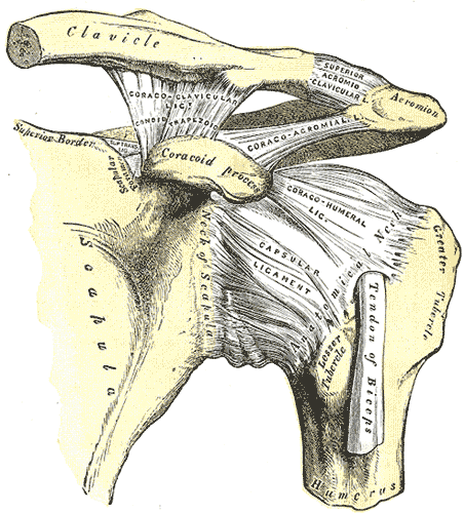SHOULDER DISLOCATION -vs- SHOULDER SEPARATION
LEFT SHOULDER
Just below that is the “ball and socket” part of the shoulder joint. The head of the arm bone (the humerus) is held into the socket of the Scapula (the shoulder blade) by a group of ligaments known as the Capsular Ligament.
When the shoulder gets hit in a certain way, sustains too much stress (weightlifting, shoveling gravel, a fall), you can damage (sprain or stretch out) the Acromioclavicular Ligament. The picture below (black background) shows the different levels of severity of Separated Shoulders. Because the Acromioclavicular ligament itself is damaged, the end of the collar bone is allowed to tip upwards. Usually this is fairly slight. But as you can see from the images below, they can get progressively severe to the point they can require surgery — depending on the degree of stretching / tearing of the Acromioclavicular Ligament.
Bear in mind that the tell-tale sign of a freshly Separated Shoulder is a painful ‘bump’ at the point (top) of the shoulder. An old dislocation will not typically hurt, although the bump remains. Once you have separated the shoulder, it never really goes back. You will always have the bump. Also bear in mind that this is a slow-healing injury. I separated my left shoulder about 16 years ago shoveling pickup load after pickup load of dirt for my garden. I have no real problem with it today as long as I do not get ignorant in the gym and try to bench press like I did back in the day. Unfortunately, TISSUE REMODELING does not really work on this particular injury.
SHOULDER DISLOCATION
The Shoulder Dislocation is a more serious injury — something you need to seek medical attention for. It is important to deal with this injury quickly. The longer a shoulder stays dislocated, the greater chance there is for complications. Also, having repeated shoulder dislocations (think of Mel Gibson’s character in Lethal Weapon) leads to permanent instability, arthritis, chronic dysfunction, and chronic pain. Besides pain, swelling, and spasm, the classic sign of a Shoulder Dislocation is a hollow area at the front top of the shoulder — the cavity left after the shoulder comes out of its socket and drops downward. Although we help lots and lots of Shoulder Problems with our Tissue Remodeling (HERE), like the Separated Shoulder, this is not one of them. Again, the Cold Laser Therapy, proper Nutritional Supplements such as LIGAPLEX, can make a huge difference in the length of time a Rehab Protocol will take (as well as its overall effectiveness).


